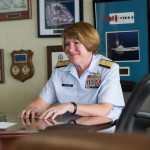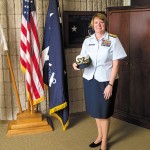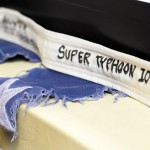The Coast Is Clear
She nearly quit the challenging Coast Guard Academy, but now Rear Adm. Cari Thomas is at the helm of Coast Guard District 14
According to Center for American Progress, women make up 59 percent of the college-educated, entry-level workforce, but only 14.6 percent of executive officers and only 4.6 percent of Fortune 500 CEOs. Opportunities for women in the U.S. military aren’t much better. Those wanting to break the glass ceiling must learn to navigate not only the technical nature of their jobs, but also a culture that is still male-dominated.
- Adm. Thomas at work ANTHONY CONSILLIO PHOTO
- Rear Adm. Cari Thomas commands Coast Guard District 14 ANTHONY CONSILLIO PHOTO
- The admiral practices on the ukulele at home in Diamond Head LAWRENCE TABUDLO PHOTO
- A remnant piece of a U.S. flag from Super Typhoon loki ANTHONY CONSILLIO PHOTO
- Rear Adm. Cari Thomas mans Diamond Head Lighthouse LAWRENCE TABUDLO PHOTO
“It hasn’t been easy,” admits the 52-year-old Coast Guard Academy graduate. “There were people along the way who didn’t have respect for women, or didn’t understand I was looking for an opportunity to do a good job.”
Thomas went on to say that, while acceptance was, at times, difficult, there were a number of senior male leaders who recognized her potential and gave her opportunities to strive.
Good thing.
Had the walls been too high, the U.S. would have lost a gifted commanding officer.
Thomas is impressive. She is smart, has an easy smile, is open with her opinions and promotes a system of leadership that dismissed the notion that military leadership consists of solely giving orders. (This opinion was voiced often in opposition to retired Gen. Francis Wiercinski after he was named a finalist for UH president.)
Thomas’ Coast Guard career took root at the age of 17 when her father, James Batson, took her to the ocean for the first time. She was fascinated by the experience, and wanted to learn every shell and every marine mammal. She wanted to be Jacques Cousteau. Instead, she became an engineer. The career prospects were better and scholarships easier to come by.
After looking at any number of colleges and military academies, she settled on the Coast Guard. The service would pay for her education and, unlike the other services, the Coast Guard placed no restrictions on duty assignments.
“I thought I’d get my education, my family and get out. Well, I got my education, I got my family, but I forgot to get out,” she says with a smile.
Military academies aren’t easy. In addition to strict academic requirements, students also have athletic and military obligations. Thomas struggled. Adjusting to military life was a challenge, and she wasn’t cutting it as a student.
She called her parents, letting them know of her thoughts to leave the academy. Mom would have none of that, and made her feelings clear in a letter.
“Dear Cari,” Elizabeth Batson wrote. “It is midnight and I am so mad at you I could spit. I don’t know what you think you are going to do, but you need to turn on some of the midnight oil and learn how to study a little harder or you’re going to flunk out of there and you won’t be able to land a job anywhere.”
It worked. “I suddenly learned that, in addition to being a good leader, you need to be a good follower,” admits Thomas, “and I didn’t do that.”
By the end of her senior year, she had rebounded enough to finish in the middle of her class. Upon her graduation in 1984, the Coast Guard put its newest officer right in the middle of perhaps the largest law enforcement and humanitarian mission in the service’s history.
The Caribbean in the mid-’80s and early ’90s was awash in drug smugglers and refugees, all focused on reaching the U.S.
In May 1992, the Coast Guard rescued 10,404 Haitian refugees, who fled the country following an army coup that overthrew President Jean-Bertrand Aristide. In a six-month period, more than 34,090 Haitians were pulled from 461 vessels, according to the New York Times. This followed the 120,000 Cuban refugees who boarded overcrowded and rickety crafts a decade earlier.
“In all my years at sea, it always made me appreciate being an American,” says Thomas, who spent nine years patrolling the region, between 1984 and 1995. “Here these people would leave their countries for a better life in our country and leave everything — their families, their belongings, everything.
“I remember one grandmother who was in her 80s. We had this big boatswain’s mate who reached over and got her up on deck, and she just gave him the biggest bear hug you could imagine. It made you smile.”
Thomas says the biggest advantage the Coast Guard offers is the chance to do almost anything. This is not a stretch. Although missing from headlines regularly reserved for ground combat missions, the Coast Guard has a greater everyday impact on ordinary Americans than any of its counterparts.
It provides security and humanitarian assistance. They inspect ships, set safety and training standards, conduct port assessments, and act as liaisons among ship owners, customs officials and local authorities. Of the eight or nine elements in the global supply chain, the Coast Guard is involved in half. And Aug. 3, when a recreational vessel sank in Ka’iwi Channel, it was a Coast Guard MH-65 Dolphin helicopter crew from Air Station Barbers Point that rescued the individuals and placed them safely at Sandy Beach. The Coast Guard even enforces the laws in Exclusive Economic Zones for nations that lack the resources.
That they do their jobs with such small numbers is impressive. District 14 has just 824 active duty members, whereas the Army has more than 19,000 in Hawaii alone.
“Being small is both an asset and a challenge for us. It’s an asset because we are agile and have such a broad spectrum of responsibilities that we can turn on a dime and go from being humanitarian to being in security,” explains Thomas.
Each day, District 14 averages one saved life, responds to five vessels in distress, saves $17,000 in property and responds to two oil or chemical spills.
That’s a job well done. Thomas’ main duty is to be the Coast Guard’s chief organizer, or juggler, in the Pacific. She breaks the duties into four stages: operational, international, oversight and support. To do that, she taps into the talent around her.
Dictating orders would be easier, but that, she believes, leads to poor results. The direct involvement of stakeholders is critical in developing good policy, and she counts on all parties to have an ownership stake in the decision-making.
“You have to have buy-in,” she says. “The people who didn’t have anything to do with it and didn’t develop it, won’t trust it.”
In charge of putting together a U.S. delegation to negotiate an international oil spill agreement in the Arctic, Thomas brought together the usual suspects — State Department, Interior, Commerce, NOAA — along with a representative from an environmental NGO and one representing business interests wanting to open the area for drilling.
“It made for some very spirited discussions, but the council is a consensus-based group,” she says. “We were trying to build a consensus rather than jam ourselves in.
“We carry a very loud voice, and you learn when to use that loud voice and when to do a lot of listening. In Oceania, where these countries have very little, it is so, so important to listen to what their needs are and try to meet their needs, and not just come in with a heavy-handed U.S. position.”
That’s real leadership.
Where Thomas goes from here is uncertain. She’s been in service for 34 years, has a 25-year-old daughter Andi living in Virginia, and a husband of 28 years who himself retired from the Coast Guard three years ago — they met at the academy. There are not a lot upward positions for a two-star admiral, so this may be her final duty station. That will be a big disappointment to her husband, who is not yet ready to part with their amazing Diamond Head Lighthouse home, a perk that comes with her job.
“I told her I’m staying no matter what she does,” says the jovial and perfectly relaxed Gary Thomas, who answers their front-gate entrance barefoot, wearing surf shorts and a T-shirt.
One final note on being a woman in charge:
While in command of the Coast Guard Training Center in Cape May, N.J., Thomas underwent a 360-degree evaluation, where one retired Coast Guard chief described her leadership style as being “motherly.”
She was confused by the label, thinking motherly sounded “wussy,” but the evaluator explained.
His mother, he said, was compassionate and would do anything for her children. But don’t cross her because she is going to hold you to a high standard and you don’t want to get on her bad side.
Caring, but tough.
It fits.








